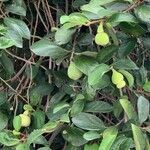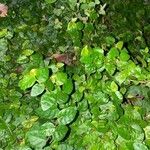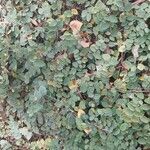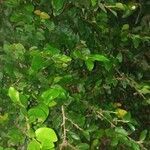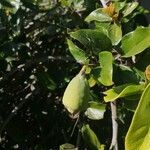Shrubs, climbers or scandent. Rooting branchlets sterile. Stipules lanceolate, with yellow brown silklike hairs. Leaves distichous, leaf blade on fertile branchlets different in shape than ones on sterile branches, ovate-cordate, ovate-elliptic, or oblong-ovate, 5-12 × 2-5 cm, abaxially pubescent, base rounded to slightly cordate, margin entire, apex obtuse, acute, or acuminate; veins conspicuous, honeycomblike; basal lateral veins elongated, secondary veins 3 or 4 on each side of midvein, abaxially prominent, and adaxially impressed. Figs axillary on normal leafy branches, solitary, yellowish green to pale red when mature, pear-shaped to ± globose or cylindric, 4-8 × 3-5 cm, shortly yellow pubescent when young, basally attenuate into a short stalk, apical pore truncate, navel-like, or acuminate; peduncle to ca. 1 cm, thick; involucral bracts triangular-ovate, densely covered with long pubescence, persistent. Male flowers: many, in several rows near apical pore, pedicellate; calyx lobes 2 or 3, linear; stamens 2; filaments short. Gall flowers: pedicellate; calyx lobes 3 or 4, linear; style lateral, short. Female flowers: pedicel long; calyx lobes 4 or 5; achenes ± globose, with adherent liquid. Fl. and fr. May-Aug.
Woody vines or sprawling shrubs , vines closely appressed to substrate, shrubs loosely ascending, evergreen. Roots adventitious, nodal. Branches appressed-pubescent when young, glabrous in age. Leaves dimorphic; stipules 0.3-0.8 cm; petiole 1.5-2 cm. Leaf blade oblong to ovate-elliptic or obovate, 4-10 × 2.5-4.5 cm, those of appressed climbing stems distichous, appressed, smaller (than those of loose, extended, flowering stems), spreading, leathery, base obtuse to rounded, margins recurved, apex obtuse to nearly acute; surfaces abaxially glabrous or puberulent on veins, adaxially glabrous, prominently reticulate; basal pair of veins 1; lateral pairs of veins 3-6, straight; secondary veins prominent. Syconia solitary, pedunculate, green, oblong, obovoid, pyriform, or nearly globose, 3-4 × 3-4 cm, slightly pubescent but becoming glabrescent in age; peduncle thick, 8-15 mm; subtending bracts ovate, 5-7 mm; ostiole closed by 3 bracts, umbonate.
Woody creeper climbing by adventitious roots, generally villous. Leaves distichous; lamina broadly ovate, elliptic to oblong, cordate at base, obtuse to subacute at apex, 4–10 cm long, 2.5–6 cm wide (leaves of climbing stems ovate, 1–3 cm long and shortly petiolate vs leaves of spreading fruiting branches elliptic to oblong, 4–10 cm long with petiole 1–2 cm long, fide Harden 1990: 344), pitted beneath; lower juvenile leaves usually appressed on climbing twig; lateral veins 3–6 pairs; petiole 2–4 cm long; stipules to 1.5 cm long, appressed-villous. Figs solitary, pyriform/obovoid, 3–6 cm long, 2.5–3.5 cm diam., sparsely villous, ripening purple to black, truncate and umbonate at apex; internal bristles abundant; basal bracts 5–7 mm long. Male flowers at distal half of fig, in many rows, 10–17 mm long; stamens 2, rarely 3. Female flowers with sessile ovary; style simple, lateral.
Evergreen, monoecious, scandent shrub becoming ± erect at flowering. Young stems moderately to densely hairy, becoming glabrous. Lvs glabrous above, finely hairy below when young but becoming ± glabrous, not lobed, entire, ovate to elliptic, cordate and often asymmetric at base, obtuse to acute, 1.5-3-(4) cm long on young scandent shoots, up to 12 cm long on the more erect flowering shoots; veins very prominently raised below; petiole < blade; stipules 2 per node, densely hairy, triangular, caducous. Infl. hairy, pyriform to subglobose, green, shortly pedunculate. Syncarp purplish pink, 2-8 cm long; achenes not seen.
A climbing fig. It clings to other plants. There are climbing aerial roots in the axils of leaves. It can climb 14 m or more. It often climbs up buildings. It can spread very widely. The leaves are of 2 types. The leaves are small, flat and heart shaped. They are 4-5 cm long. With age, new non climbing growth appears. These form thick stem. This growth has larger leaves which are fleshy. The flowers are very small. The occur singly. The fig or fruit are barrel-like and purplish green. They can be 5 cm long by 3 cm wide. The young figs are green but turn purple as they ripen.
Root-climbers. Blade narrowly ovate to elliptic, those of the sterile, rooting branchlets up to 3 x 2 cm, those of the fertile, non-rooting branchlets up to 10 x 4.5 cm, apex obtuse, base rounded to subcordate; secondary veins 3-5 pairs or 2x 5-7, respectively. Figs pedunculate, pyriform to obovoid, up to 7 cm long.
A native of China and Japan, which is commonly grown as an ornamental creeper on houses.
